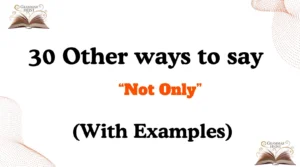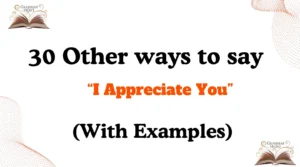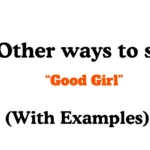Finding the right words when writing emails or messages matters more than many people realize. A phrase like “please advise” may feel short and professional, but it can also sound a little cold, blunt, or impersonal. If you want to make your message feel warmer, respectful, and human, it’s better to explore alternatives.
This article will give you 30 other ways to say “please advise” that are easy to use, professional, and caring. These alternatives help you sound more empathetic and show you value the other person’s guidance and opinion.
What Does “Please Advise” Mean?
The phrase “please advise” is commonly used in emails or workplace communication. It basically means:
- “Can you guide me?”
- “What do you think I should do?”
- “I need your input or confirmation.”
It’s a request for direction or feedback, but it may lack warmth.
Is It Professional/Polite to Say “Please Advise”?
Yes, it’s professional—but not always the most polite-sounding. Some people read it as:
- Too direct, like giving an order.
- Formal, which can feel distant.
If you want to build better connections, using alternatives makes your message clearer and friendlier.
Pros or Cons
Pros of “Please Advise”:
- Clear and simple.
- Accepted in formal settings.
- Time-saving.
Cons of “Please Advise”:
- Can sound cold or demanding.
- Lacks empathy.
- May weaken relationship-building.
Synonyms For “Please Advise”
- Could you please share your thoughts?
- I would appreciate your guidance.
- What would you recommend?
- Could you clarify this for me?
- May I get your input?
- I’d be grateful for your advice.
- What are your thoughts?
- Could you help me understand?
- Would you mind sharing your advice?
- Could you give me your perspective?
- Could you guide me on this?
- I’d like your thoughts on this.
- Could you help me decide?
- What do you suggest?
- Could I get your feedback?
- Do you think this works?
- Could you point me in the right direction?
- Would love your advice on this.
- Could you let me know what you think?
- I’d value your opinion.
- Can you walk me through this?
- Could I get your take on this?
- What’s your opinion on this?
- Could you help me with your advice?
- How do you suggest I move forward?
- I’d love to hear your feedback.
- Could you let me know your recommendation?
- Would appreciate your insights.
- Could you provide your feedback?
- I’d like your recommendation.
1. Could you please share your thoughts?
Scenario: When you want feedback or opinions on a decision.
Examples:
- Could you please share your thoughts on the budget proposal?
- Before we confirm, could you please share your thoughts?
- I’d appreciate it if you could please share your thoughts on this draft.
Tone: Polite and respectful.
Explanation: This phrase values the other person’s opinion while keeping the request warm and collaborative.
2. I would appreciate your guidance.
Scenario: When asking a senior, mentor, or manager for direction.
Examples:
- I’m unsure which option is better—I would appreciate your guidance.
- Before I proceed, I would appreciate your guidance on this matter.
- Could you review this? I would appreciate your guidance.
Tone: Gentle and appreciative.
Explanation: It shows humility and highlights respect for the other person’s expertise.
3. What would you recommend?
Scenario: When you want practical advice or solutions.
Examples:
- We’re considering two vendors—what would you recommend?
- If this happens again, what would you recommend?
- I’m not certain of the next step—what would you recommend?
Tone: Open and curious.
Explanation: This invites advice naturally and shows you trust the person’s judgment.
4. Could you clarify this for me?
Scenario: When instructions or details aren’t clear.
Examples:
- I read the update, but could you clarify this for me?
- Before I continue, could you clarify this for me?
- The email wasn’t fully clear—could you clarify this for me?
Tone: Respectful and professional.
Explanation: Instead of demanding answers, this gently asks for clearer information.
5. May I get your input?
Scenario: When you want someone’s thoughts or suggestions in a collaborative setting.
Examples:
- May I get your input on the new campaign design?
- Before we finalize, may I get your input?
- I’d like to make sure we’re aligned—may I get your input?
Tone: Friendly and cooperative.
Explanation: This sounds open and respectful, showing you value their ideas and don’t want to make decisions alone.
6. I’d be grateful for your advice.
Scenario: When you want thoughtful guidance in a respectful way.
Examples:
- I’d be grateful for your advice on this career decision.
- Before moving forward, I’d be grateful for your advice.
- Could you check this and share? I’d be grateful for your advice.
Tone: Warm and appreciative.
Explanation: Expresses gratitude before receiving help, making the request sound more genuine and heartfelt.
7. What are your thoughts?
Scenario: When asking for opinions in a casual or professional way.
Examples:
- I’ve drafted the proposal—what are your thoughts?
- We may adjust the schedule; what are your thoughts?
- Here’s the first version of the report—what are your thoughts?
Tone: Conversational and approachable.
Explanation: Short, simple, and effective—shows openness to feedback without being too formal.
8. Could you help me understand?
Scenario: When something isn’t clear and you want a patient explanation.
Examples:
- Could you help me understand the new policy?
- Before I make changes, could you help me understand this section?
- Could you help me understand what’s expected here?
Tone: Respectful and humble.
Explanation: This shows a willingness to learn and avoids sounding demanding.
9. Would you mind sharing your advice?
Scenario: When you want to be extra polite in asking for someone’s guidance.
Examples:
- Would you mind sharing your advice on this issue?
- Before I proceed, would you mind sharing your advice?
- I’d really value it if you would mind sharing your advice.
Tone: Courteous and polite.
Explanation: By using “would you mind,” the request feels soft and considerate.
10. Could you give me your perspective?
Scenario: When you want someone’s viewpoint or opinion.
Examples:
- Could you give me your perspective on the client’s response?
- Before deciding, could you give me your perspective?
- I’d like a second opinion—could you give me your perspective?
Tone: Respectful and thoughtful.
Explanation: Asking for “perspective” feels professional and open, showing you value different viewpoints.
11. Could you guide me on this?
Scenario: When you need direction on the next step.
Examples:
- Could you guide me on this project update?
- Before I continue, could you guide me on this point?
- I’m uncertain about the approach—could you guide me on this?
Tone: Professional and respectful.
Explanation: This phrase positions the other person as a mentor or expert, showing humility and willingness to learn.
12. I’d like your thoughts on this.
Scenario: When sharing something and inviting feedback.
Examples:
- I’ve drafted the email—I’d like your thoughts on this.
- Before sending, I’d like your thoughts on this proposal.
- Here’s the plan—I’d like your thoughts on this.
Tone: Warm and collaborative.
Explanation: This encourages open sharing and shows you value the other person’s contribution.
13. Could you help me decide?
Scenario: When you have multiple options and need help choosing.
Examples:
- I’m torn between two vendors—could you help me decide?
- Could you help me decide which date works best?
- Before committing, could you help me decide?
Tone: Friendly and open.
Explanation: It shows you trust the other person’s judgment and want them involved in the decision.
14. What do you suggest?
Scenario: When seeking solutions or ideas directly.
Examples:
- The system crashed again—what do you suggest?
- If the client doesn’t reply, what do you suggest?
- We’re considering two layouts—what do you suggest?
Tone: Direct but polite.
Explanation: Simple and clear, it makes the request practical and to the point.
15. Could I get your feedback?
Scenario: When reviewing drafts, reports, or projects.
Examples:
- I finished the draft—could I get your feedback?
- Before presenting, could I get your feedback?
- Could I get your feedback on this design?
Tone: Professional yet approachable.
Explanation: A respectful way to invite constructive criticism without pressure.
16. Do you think this works?
Scenario: When testing or validating ideas.
Examples:
- I adjusted the plan—do you think this works?
- Here’s a new approach—do you think this works?
- Do you think this works for the client’s request?
Tone: Conversational and light.
Explanation: This sounds less formal, making it perfect for brainstorming or team discussions.
17. Could you point me in the right direction?
Scenario: When you don’t need full details, just where to start.
Examples:
- I’m lost on this process—could you point me in the right direction?
- Before I move forward, could you point me in the right direction?
- Could you point me in the right direction for resolving this issue?
Tone: Friendly and collaborative.
Explanation: This phrase adds warmth and suggests teamwork rather than authority.
18. Would love your advice on this.
Scenario: When you want a quick, warm, and casual request.
Examples:
- Would love your advice on this career path.
- Before presenting, would love your advice on the design.
- I’m thinking of this approach—would love your advice.
Tone: Casual and friendly.
Explanation: This phrase feels less formal, making it good for colleagues you have a comfortable relationship with.
19. Could you let me know what you think?
Scenario: When sharing work or updates that need input.
Examples:
- I’ve updated the slides—could you let me know what you think?
- Could you let me know what you think about the schedule?
- Here’s my draft—could you let me know what you think?
Tone: Approachable and polite.
Explanation: It adds warmth and turns the request into a natural conversation.
Read More:30 Other Ways to Say ‘The Text States’ (With Examples)
20. I’d value your opinion.
Scenario: When showing deep respect for the other person’s judgment.
Examples:
- I’d value your opinion on the proposal.
- Before I make changes, I’d value your opinion.
- This seems tricky—I’d value your opinion.
Tone: Respectful and appreciative.
Explanation: It highlights trust and makes the other person feel recognized and important.
21. Can you walk me through this?
Scenario: When you need step-by-step help or explanation.
Examples:
- Can you walk me through this report format?
- I’m new to the process—can you walk me through this?
- Can you walk me through this section before I submit it?
Tone: Respectful and practical.
Explanation: This shows you’re eager to learn and asks for patient guidance instead of just an answer.
22. Could I get your take on this?
Scenario: When looking for a quick opinion.
Examples:
- I’ve updated the draft—could I get your take on this?
- Before sending, could I get your take on this?
- Could I get your take on this plan for tomorrow’s meeting?
Tone: Casual but professional.
Explanation: This phrase feels natural and conversational, ideal for colleagues or peers.
23. What’s your opinion on this?
Scenario: When you want clear thoughts and viewpoints.
Examples:
- What’s your opinion on this marketing strategy?
- Before deciding, what’s your opinion on this approach?
- What’s your opinion on this proposal draft?
Tone: Direct yet respectful.
Explanation: This is straightforward but polite, showing you’re open to different views.
24. Could you help me with your advice?
Scenario: When combining both assistance and guidance.
Examples:
- Could you help me with your advice on this issue?
- I’d like to confirm—could you help me with your advice?
- Before closing, could you help me with your advice?
Tone: Supportive and respectful.
Explanation: This makes the request sound collaborative rather than demanding.
25. How do you suggest I move forward?
Scenario: When looking for a clear next step.
Examples:
- How do you suggest I move forward with this project?
- Before replying to the client, how do you suggest I move forward?
- The plan is unclear—how do you suggest I move forward?
Tone: Professional and solution-focused.
Explanation: This directs the question toward action, showing you want progress and guidance.
26. I’d love to hear your feedback.
Scenario: When inviting input in a warm, friendly way.
Examples:
- I drafted the email—I’d love to hear your feedback.
- I’d love to hear your feedback on this report before submission.
- Could you check the slides? I’d love to hear your feedback.
Tone: Warm and inviting.
Explanation: This feels caring and human, encouraging honest sharing.
27. Could you let me know your recommendation?
Scenario: When expecting a clear solution.
Examples:
- Could you let me know your recommendation for the next step?
- Before I continue, could you let me know your recommendation?
- The system has two options—could you let me know your recommendation?
Tone: Professional and polite.
Explanation: It sets the expectation for clear direction but keeps the tone soft.
28. Would appreciate your insights.
Scenario: When you want expert-level input.
Examples:
- Would appreciate your insights on this client’s feedback.
- Before finalizing, would appreciate your insights.
- I’d love to improve this—would appreciate your insights.
Tone: Respectful and thoughtful.
Explanation: This conveys humility and emphasizes that you value the person’s deeper experience.
29. Could you provide your feedback?
Scenario: When asking in a more formal, businesslike tone.
Examples:
- Could you provide your feedback on the updated budget?
- Before the deadline, could you provide your feedback?
- Could you provide your feedback on this presentation?
Tone: Formal and professional.
Explanation: This works well in official or corporate settings where a direct style is expected.
30. I’d like your recommendation.
Scenario: When you’re ready to make a decision but want expert input.
Examples:
- I’m unsure which vendor to choose—I’d like your recommendation.
- Before we proceed, I’d like your recommendation.
- I’ve listed two options—I’d like your recommendation.
Tone: Professional and respectful.
Explanation: It shows trust in the other person’s decision-making ability and makes them feel valued.
Conclusion
Using alternatives to “please advise” can make your communication feel more clear, warm, and respectful. Whether you’re emailing a colleague, asking for guidance, or seeking feedback, choosing the right phrase helps you build better connections and show appreciation for the other person’s time and expertise.

Mia Rose is a skilled language expert with a deep passion for helping individuals master the art of writing and communication. With years of experience in the field, Marie brings a thoughtful and tailored approach to grammar, style, and language improvement. Her goal is to empower others to express themselves with clarity, precision, and confidence in every written word.













